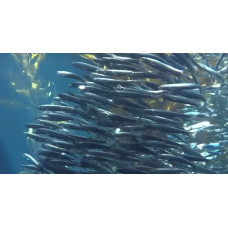Latin name
Sardinella brachysoma
Other names
Indian herring, Indian sprat.
Identification
Body deep; total number of scales from 29 to 32. Vertical furrows on the scales overlapping or sometimes continuous in the middle of the scales, numerous small holes on the posterior part of the scales. Differs from other deep-sea species mainly by the smaller number of gill stamens and the presence of a dark spot on the dorsal fin.
Features of fish fins
Dorsal spines (total): 0; Dorsal soft rays (total): 13-21; Anal spines: 0; Anal soft rays: 12-23.
Fish colouring
Very similar to S. hualiensis, which has dark dorsal and caudal fin tips.
Distribution
Indo-West Pacific: Madagascar, Madras, Indonesia, Northern Australia.
Habitat
Marine tropical pelagic-neritic species. Depth range 0 to 50 m.
Size
Maximum length: 13 cm. Normal length: 12 cm.
Behavior
Form schools in coastal waters.
Food and feeding habits
The diet consists of zooplankton and phytoplankton, mainly paddle crayfish.
Reproduction
Spawning occurs in the coastal zone, with juveniles developing close to shore in the warm waters of estuaries and lagoons.
Fishing
Of negligible commercial value. Of no interest to fishermen.
Relationship with a person
A species harmless to humans.
| Classification | |
| Phylum | Chordata |
| Class | Actinopterygii |
| Squad | Clupeiformes |
| Family | Dorosomatidae |
| Genus | Sardinella |
| Species | S. brachysoma |
| Features | |
| Conservation status | Least Concern |
| Habitat | Pelagic |
| Life span, years | No information |
| Maximum body weight, kg | No information |
| Maximum length, cm | 13 |
| Sailing speed, m/s | No information |
| Threat to people | Edible |
| Way of eating | Planktonophage |
Deepbody sardinella
Tags: deepbody sardinella

